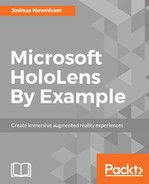One of the most compelling features of HoloLens is its ability to place and track virtual/digital content in the real world. It does this using a process known as spatial mapping, whereby the device actively scans the environment, building its digital representation in memory. In addition, it adds anchors using a concept called spatial anchors. Spatial anchors mark important points in the world in reference to the defined world origin; holograms are positioned relative to these spatial anchors, and these anchors are also used to join multiple spaces for handling larger environments.
The effectiveness of the scanning process will determine the quality of the experience; therefore, it is important to understand this process in order to create an experience that effectively captures sufficient data about the environment. One technique commonly used is digital painting; during this phase, the user is asked to paint the environment. As the user glances around, the scanned surfaces are visualized (or painted over), providing feedback to the user that the surface has been scanned.
However, scanning and capturing the environment is just one part of understanding the environment, and the second is making use of it; some uses include the following:
- Occlusion: One of the shortfalls of creating immersive MR experiences using single camera devices (such as Smartphones) is the inability to understand the surface to occlude virtual content from the real world when obstructed. Seeing holograms through objects is a quick way to force the user out of the illusion; with HoloLens, occluding holograms with the real world is easy.
- Visualization: Sometimes, visualizing the scanned surfaces is desirable, normally an internal effect such as feeding back what part of the environment is scanned to the user.
- Placement: Similar to occlusion in that it creates a compelling illusion, holograms should behave like the real objects that they are impersonating. Once the environment is scanned, further processing can be performed to gain greater knowledge of the environment, such as the types of surfaces available. With this knowledge, we can better infer where objects belong and how they should behave. In addition to creating more compelling illusions, matching the experience with the user's mental model of where things belong makes the experience more familiar, thus easing adoption by making it easier and more intuitive to use.
- Physics: HoloLens makes the scanned surfaces accessible as plain geometry data, which means we can leverage the existing physics simulation software to reinforce the presence of holograms in the user's environment. For example, if I throw a virtual ball, I expect it to bounce off the walls and onto the floor before settling down.
- Navigation: In game development, we have devised effective methods for path planning. Having a digital representation of our real world affords us to utilize these same techniques in the real world. Imagine offering a visually impaired person an opportunity to effectively navigate an environment independently or assisting a parent to find their lost child in a busy store.
- Recognition: Recognition refers to the ability of the computer to classify what objects are in the environment; this can be used to create a more immersive experience, such as having virtual characters sit on seats, or to provide a utility, such as helping teach a new language or assisting visually impaired people so that they can better understand their environment.
